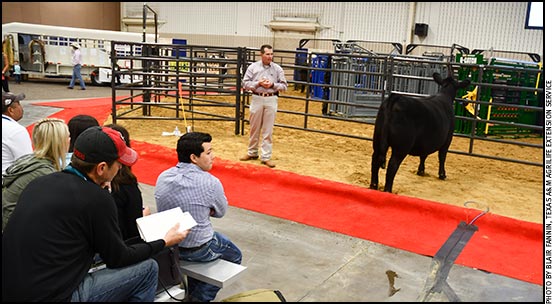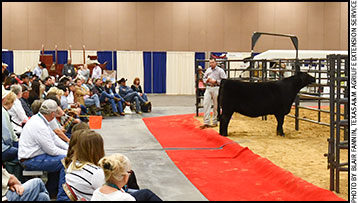
Jason Cleere, Texas A&M AgriLife Extension Service beef cattle specialist, College Station, discusses the importance of using both data and visual analysis when purchasing female replacement cattle and breeding bulls at the TSCRA Convention in Fort Worth.
Both Data, Visual Aspects of Cattle Count When Making Purchases
Expert gives tips on proper cattle conformation.
When buying female replacement cattle or breeding bulls, it’s important to use data and visual observations to make the best selections, according to a Texas A&M AgriLife Extension Service expert.
Jason Cleere, beef cattle specialist from College Station, gave a series of demonstrations on conformation at the recent Texas and Southwestern Cattle Raisers Association (TSCRA) Convention in Fort Worth advising the best methods for buying replacements.
“If I look at what the cow looks like visually first and not look at the data, things like expected progeny differences, or EPDs, birth weight, other evaluations, I may not be making the best choice,” Cleere said. “When it comes to selecting female cattle, I look at the feet and the legs first. You’ve got to start at the ground first.”
Cleere said he wants to choose female cattle that have sound feet and good bone structure.

Jason Cleere discusses conformation at the TSCRA Convention.
“Over time, if you have a cow that does not meet good physical criteria, those joints in the hips and shoulders will start to align, and she will lose cushion and mobility,” Cleere said. “That’s going to lead to problems down the road.”
This is also the case when choosing breeding bulls, Cleere said.
“When a bull mounts a cow and comes down, he hits that ground really hard. A bull that’s too straight, over time, will wear those joints out,” he said. “When we see cows that have structural problems, they usually are thinner. As you go further west, you need to make sure they are structurally sound because they cover a lot of ground out west where there is flat, open territory. They’ve just simply got more ground to cover.”
Bulls make a tremendous influence on the entire calf crop, Cleere said.
“That’s why it’s important to take into consideration all aspects of a bull from both the data and visual composition.”

Editor’s Note: Blair Fannin is a media relationship specialist with Texas A&M AgriLife Communications.






